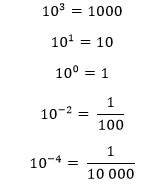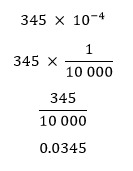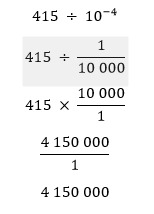Don't wanna be here? Send us removal request.
Text
Place value, ordering and rounding
Multiplying and dividing decimals mentally
Multiply decimals can be tricky yet it can be as simple as multiplying whole numbers. My steps on multiplying decimals:
count how many digits available after the decimal point from numbers you want to multiply. Store that info.
ignore the decimal point (the decimal numbers become whole numbers). Do the multiplication between numbers.
return the decimal point based on the info from step 1
For example: 0.3 x 5. (1) In total from these two numbers, we have 1 digit behind the decimal point. It means the result will have 1 digit behind the decimal point. (2) ignore the decimal point of these 2 numbers. 3 X 5 = 15. (3) return the decimal point. How many digit behind the decimal point is for the result? 1. So the answer is 1.5.
Another example : 0.04 x 1.2. (1)In total, we have 3 digits behind the decimal point. It means the result of this calculation will have 3 digits behind the decimal point. (2) ignore the decimal point. 4 x 12 = 48. (3) Based on step 1, the result will have 3 digits behind the decimal point. Hm, the result only has 2 digits! No worries, just add 0 . The result is 0.048.
For dividing decimal, I will use my knowledge on fraction and equivalent fraction . My steps on dividing decimals:
write them as a fraction
find the equivalent fraction with the goal of eliminating decimal point
do the division

Exercise time ! Work these out mentally. The answer will be available at the end of the post.
1.3 x 0.02
24 : 0.04
(12 x 0.2) : (0.3 x 0.2)
Multiplying and dividing by powers of 10
Things you need to remember about powers of 10

Multiply a number by the power of 10 with the negative index is the same as divide the number by the power of 10.

Divide a number by the power of 10 with the negative index is the same as multiply the number by the power of 10.

Exercise :

Rounding
For this topic, you need to understand about the place value, significant figure and decimal place. We jump directly to the example.

If, I want to round 3 451.67 to the nearest whole number, it means I will keep the number until 3 451. Yet, there is a possibility that the last digit 1 changes. Depending on the digit after 1. If the digit after 1 is 5 or more, the last digit of the number will be increased by 1. If not, stay the same. Look on the number, after 1 we have 6. It is more than 5. So the last digit is increased by 1. The result is 3 452. The result will be until the digit that takes the position of the nearest whole number.
Another example using the same number. I will round the number to 3 significant figures (3 S.F.). I will keep the number until 3 45. Now, check the digit after 5. 1 is less than 5, stay the same. After that, check the original value position of 5. It is ten. On the result, 3 45, the 5 takes the position of one. Hm, we need to add something so the 5 takes the position of 10. Yeah, we need to add a 0 after 5. The result is 3 450.
Order of operations.
BEDMAS : Bracket, Exponention (power), Division Multiplication and Addition Subtraction.
Note: if you have division and multiplication or addition and subtraction on the same problem, you need to do it from left to right.
I will give you a problem : work out the value of this expression when x = 2 and y = -3 for 4x^2 - y
The answer is 0.026 ; 600 ; 40 ; 15 000 ; 0.012 ; 342 000 ; 19
See you !
0 notes
Text
Sequences and functions
Generating sequences
A sequence is an ordered set of numbers/ terms arranged according to a specific rule. For example : 3, 7, 11, 15, 19. This sequence has 5 terms, in order according to a specific rule, added by 4.
There are two types of sequence:
Linear Sequence : each term will be increased or decreased by the same number. For example : 5.3, 4.5, 3.7
Non-Linear Sequence : each term will be increased or decreased by a different number. For example : 2, 4, 8, 16
Finding the nth term
You can find the value of a term based on its position. It is called as an nth term. The value of n is the position of the term. Here is the general way to construct the nth term of 3, 7, 11, 15, 19.
find the rule of the sequence
multiply it with the value of n
find the value of term before term position 1
place the result of step no 3 next to the result of step no 2
Now, we will execute them. (1) the rule of the sequence is "added by 4". (2) multiply it with the value of n, 4n. (3) find the value available before term position 1 is 3 - 4. The result is -1. (4) place the result of step no 3 next to the result of step no 2, 4n - 1. So the nth term of 3, 7, 11, 15, 19 is nth= 4n - 1
With this nth term, we can find the value of term in any position! For example, we want to know the value of term position 121 of the above sequence, 3, 7, 11, 15, 19. It means the value of n is 121. The nth term of this sequence is 4n - 1. Substitute the n with 121. It becomes nth term = (4 x 121) - 1. The result is 483. The value of term position 121 for this sequence is 483.
What will be nth term of 5.3, 4.5, 3.7? and find the value of term position 98. The answer of this question will given at the end of the post.
Finding the inverse of a function
Function can be in 3 different forms, an equation, a mapping and an function mapping. When you give an input to a function, you will get an output.
The example of function in the form of an equation is y = 3x - 2. From this equation, we can say " to get the value of y, we need to multiply the value of x by 3 and minus it by 2". The conclusion, x is the required input so that the function or the calculation can be executed in order to get the output, y.
The look of the mapping form for the same function is x → 3x - 2. The most left, x, is the input. The next one is the process should be done to the value of x (function) in order to get the output, y.

Above is the example of a function machine. X is the input to the function. The function will multiply the value of x by 3 and minus it by 2. The result of the function becomes the value of y. Y is the output.
The process or the function is read from left to right. When we read it in the opposite way, we can called it as inverse of the function. Here are the steps for inversing a function.
change the x to y and y to x
use the left arrow instead of right arrow
change the operation to the opposite one , minus to plus, plus to minus, multiply to divide, divide to multiply, square to square root, square root to square
Here is the result of inversing the function using a function machine.

The result of inverse the function :
in the form of equation is y = (x + 2)/3
in the form of mapping is x → (x + 2)/3
Work out the inverse function for y = (x + 1)/2. The answer of this question will given at the end of the post.
NOTE: When I want to find the inverse of the function, if it is possible, I will use a function machine. This question looks simple but if you don't understand well the function is and you don't know very well about the order of operations, you might make a mistake for this question.
The answer for:
What will be nth term of 5.3, 4.5, 3.7? nth = -0.8n + 6.1
find the value of term position 98. (-0.8 x 98) + 6.1 = -72.3
The inverse function for y = (x + 1)/2. y = 2x - 1
Thank you.
#Sequence#function#generating sequence#finding the nth term#inverse of a function#checkpoint mathematics#grade 8#stage 9
1 note
·
View note